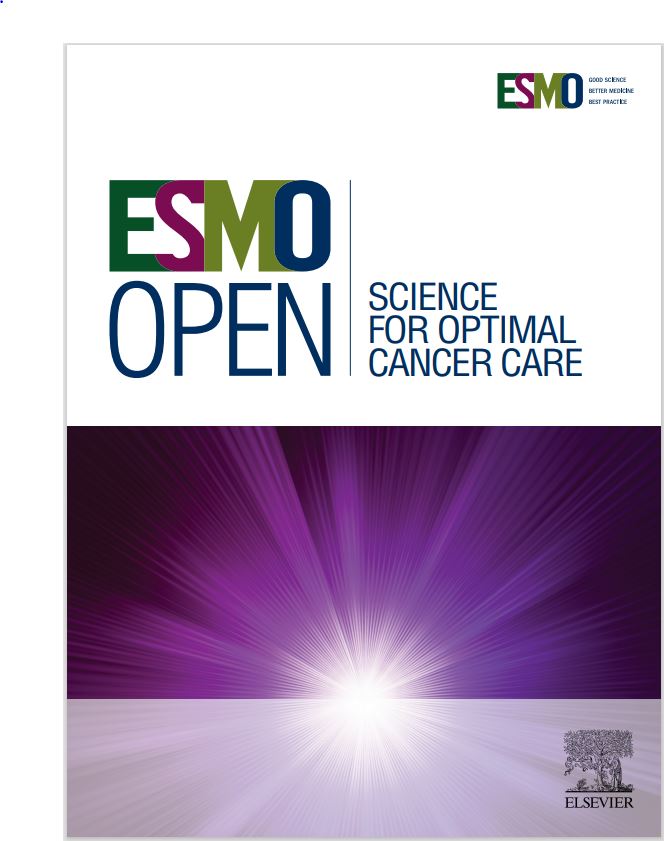在CAPRI-2 GOIM试验中,液体活检的综合基因组图谱描绘了转移性结直肠癌的突变图景,以预测FOLFIRI加西妥昔单抗的抗肿瘤疗效
IF 7.1
2区 医学
Q1 ONCOLOGY
引用次数: 0
摘要
目前关于液体活检(LBx)在预测抗表皮生长因子受体(EGFR)治疗在转移性结直肠癌(mCRC)中的疗效方面的作用的证据有限。CAPRI-2 GOIM是一项II期试验,研究了lbx综合基因组图谱(CGP)指导下,西妥昔单抗为基础的治疗方法,通过三条后续治疗线治疗RAS/BRAF野生型(WT) mCRC患者。LBx-CGP是在基线和疾病进展到一线和二线治疗时进行的。在RAS/BRAF WT循环肿瘤DNA处于进展性疾病的情况下,通过联合西妥昔单抗与不同的化疗主干继续阻断EGFR治疗。主要终点是RECIST 1.1标准的总缓解率(ORR)。LBx-CGP的肿瘤分子特征与治疗效果相关。结果192例RAS/BRAF WT微卫星稳定型mCRC患者接受FOLFIRI +西妥昔单抗治疗,基线LBx-CGP可评估疗效。137例WT肿瘤患者潜在抗EGFR耐药基因(RAS/BRAF/EGFR/PIK3CA/MAP2K1/MET/RET/ALK/ROS1/NTRK/NF1/FGFR和HER2扩增;“阴性超选择”病例的ORR为78.1%,而突变患者的ORR为54.5%[优势比2.95,95%可信区间(CI) 1.44-6.10, P = 0.001]。“阴性超选择”患者的中位无进展生存期为12.35个月(95% CI 10.58-15.4个月),而突变患者的中位无进展生存期为8.68个月(95% CI 4.87-12.1个月)(风险比0.64,95% CI 0.44-0.92, P = 0.017)。致病性变异(PV)的高癌细胞克隆性与PV的低癌细胞克隆性(9.63个月,95% CI 7.16个月至NE, P = 0.21)相比,中位无进展生存期(3.55个月,95% CI 2.57个月至NE)较差。在一线治疗失败后,大约五分之一的患者获得了潜在的抗egfr耐药基因pv,而大多数患者(78.5%)保持了RAS/BRAF WT循环肿瘤DNA。结论这些结果支持LBx-CGP整合在RAS/BRAF WT mCRC中实现疗效并优化抗egfr治疗的使用。本文章由计算机程序翻译,如有差异,请以英文原文为准。
Comprehensive genomic profiling by liquid biopsy portrays metastatic colorectal cancer mutational landscape to predict antitumor efficacy of FOLFIRI plus cetuximab in the CAPRI-2 GOIM trial
Background
Limited evidence is currently available on the role of liquid biopsy (LBx) in predicting the efficacy of anti-epidermal growth factor receptor (EGFR) therapies in metastatic colorectal cancer (mCRC).
Methods
The CAPRI-2 GOIM is a phase II trial investigating the use of LBx-comprehensive genomic profiling (CGP)-guided, cetuximab-based treatment through three subsequent lines of therapy in patients with RAS/BRAF wild-type (WT) mCRC. LBx-CGP is carried out at baseline and at progressive disease to first- and second-line therapies. In case of RAS/BRAF WT circulating tumor DNA at progressive disease, EGFR therapeutic blockade is continued by combining cetuximab with a different chemotherapy backbone. The primary endpoint is overall response rate (ORR) by RECIST 1.1 criteria. Tumor molecular characteristics by LBx-CGP are correlated with treatment efficacy.
Results
One hundred and ninety-two RAS/BRAF WT microsatellite stable mCRC patients treated with FOLFIRI plus cetuximab with baseline LBx-CGP and assessable for response were included in the analysis. One hundred and thirty-seven patients with WT tumors for potential anti-EGFR drug resistance genes (RAS/BRAF/EGFR/PIK3CA/MAP2K1/MET/RET/ALK/ROS1/NTRK/NF1/FGFR, and HER2 amplification; ‘negatively hyper-selected’ cases) had 78.1% ORR compared with 54.5% ORR for patients with mutations [odds ratio 2.95, 95% confidence interval (CI) 1.44-6.10, P = 0.001]. ‘Negatively hyper-selected’ patients had median progression-free survival of 12.35 months (95% CI 10.58-15.4 months) compared with 8.68 months (95% CI 4.87-12.1 months) for patients with mutations (hazard ratio 0.64, 95% CI 0.44-0.92, P = 0.017). High cancer cell clonality of pathogenic variants (PVs) correlated with worse median progression-free survival (3.55 months, 95% CI 2.57 months to NE) compared with low cancer cell clonality of PV (9.63 months, 95% CI 7.16 months to NE, P = 0.21). After first-line therapy failure, approximately one out of five patients had acquired PVs of potential anti-EGFR drug resistance genes, whereas RAS/BRAF WT circulating tumor DNA was maintained in most patients (78.5%).
Conclusions
These results support the integration of LBx-CGP for implementing the efficacy and for optimizing the use of anti-EGFR therapies in RAS/BRAF WT mCRC.
求助全文
通过发布文献求助,成功后即可免费获取论文全文。
去求助
来源期刊

ESMO Open
Medicine-Oncology
CiteScore
11.70
自引率
2.70%
发文量
255
审稿时长
10 weeks
期刊介绍:
ESMO Open is the online-only, open access journal of the European Society for Medical Oncology (ESMO). It is a peer-reviewed publication dedicated to sharing high-quality medical research and educational materials from various fields of oncology. The journal specifically focuses on showcasing innovative clinical and translational cancer research.
ESMO Open aims to publish a wide range of research articles covering all aspects of oncology, including experimental studies, translational research, diagnostic advancements, and therapeutic approaches. The content of the journal includes original research articles, insightful reviews, thought-provoking editorials, and correspondence. Moreover, the journal warmly welcomes the submission of phase I trials and meta-analyses. It also showcases reviews from significant ESMO conferences and meetings, as well as publishes important position statements on behalf of ESMO.
Overall, ESMO Open offers a platform for scientists, clinicians, and researchers in the field of oncology to share their valuable insights and contribute to advancing the understanding and treatment of cancer. The journal serves as a source of up-to-date information and fosters collaboration within the oncology community.
 求助内容:
求助内容: 应助结果提醒方式:
应助结果提醒方式:


